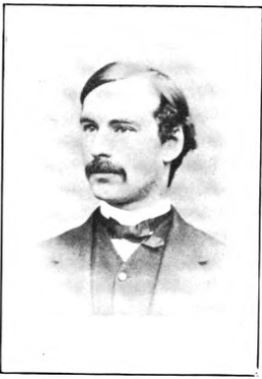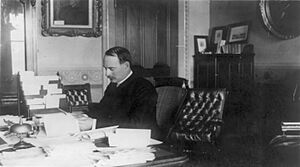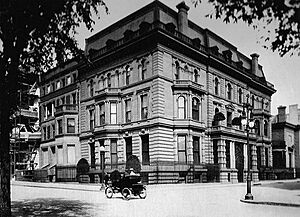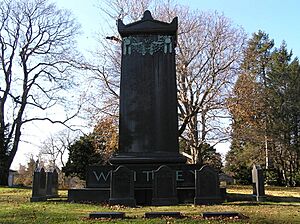William Collins Whitney facts for kids
Quick facts for kids
William Collins Whitney
|
|
|---|---|
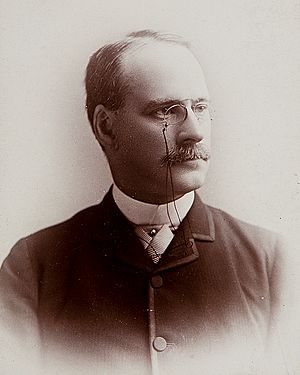 |
|
| 31st United States Secretary of the Navy | |
| In office March 7, 1885 – March 4, 1889 |
|
| President | Grover Cleveland |
| Preceded by | William E. Chandler |
| Succeeded by | Benjamin F. Tracy |
| Personal details | |
| Born | July 5, 1841 Conway, Massachusetts, U.S. |
| Died | February 2, 1904 (aged 62) New York City, New York, U.S. |
| Political party | Democratic |
| Spouses |
Flora Payne
(m. 1869; Edith Randolph
(m. 1896; |
| Children | 5, including Harry, Pauline, William, Dorothy |
| Relatives | James Scollay Whitney (Father) |
| Education | Williston Seminary Yale University (BA) Harvard University |
| Signature | |
William Collins Whitney (born July 5, 1841 – died February 2, 1904) was an important American leader in politics and business. He was a well-known member of the Whitney family. He served as the Secretary of the Navy for President Grover Cleveland from 1885 to 1889. He was known for making changes and improving things.
Contents
Early Life and Education
William Whitney was born in Conway, Massachusetts. His family had been in America since 1635, when John Whitney came from London, England. William's father was General James Scollay Whitney. His mother, Laurinda Collins, was related to William Bradford, an early governor of Plymouth.
William had an older brother, Henry Melville Whitney, who was a successful businessman. Henry started several big companies, including the Metropolitan Steamship Company. William also had sisters who married important people, like Charles T. Barney, who led a major trust company.
William went to school at Williston Seminary. He then graduated from Yale University in 1863. After Yale, he studied law at Harvard Law School. In 1864, he moved to New York City to continue his law studies. He became a lawyer in 1865.
Political Career and Public Service
William Whitney was very active in politics. In 1871, he helped start the Young Men's Democratic Club. He strongly opposed corrupt groups in New York City, like the "Tweed Ring" and "Tammany Hall."
From 1875 to 1882, he worked as the main lawyer for New York City. In this role, he helped organize the city's laws. He also successfully fought against many dishonest claims made against the city, saving a lot of money. He left this job in 1882 to focus on his own business interests.
In 1883, William Whitney became involved in a fight over a street-railway line in New York City. He worked with other businessmen to expose unfair practices. Eventually, his group received the right to operate the railway in 1886.
During President Grover Cleveland's first term (1885–1889), William Whitney served as the United States Secretary of the Navy. He did a lot to improve and modernize the United States Navy.
He made sure that contracts from the previous government were checked fairly. He also encouraged American companies to build modern steel ships and naval guns. He helped the Navy get the best materials, like strong steel armor. He also reorganized how the Navy Department handled its money and supplies. He played a key role in making the Naval War College successful.
When he left office in 1889, the Navy had many new steel ships. These included armored cruisers, protected cruisers, gunboats, and torpedo boats. These ships formed the start of the "New Navy." During his time in the government, his home in Washington, D.C. was a popular place for social gatherings.
After his time as Secretary, Whitney continued to be involved in business and politics. He helped bring about President Cleveland's third nomination in 1892. He also helped organize the Dominion Coal Company and Dominion Iron and Steel Company in Canada. These companies used the natural resources of Cape Breton Island.
Thoroughbred Horse Racing
William Whitney was also very interested in thoroughbred horse racing. He invested a lot of money in it. He hired the best trainers, bought top horses, and worked with the best jockeys.
He created Westbury Stable, which had many racehorses. He built a large stable with 84 stalls and a mile-long training track at his summer home in Old Westbury, New York. His horses were trained by famous people, both in the United States and England.
Whitney owned many properties, including a city home in New York, a large estate in Wheatley Hills, New York, and a house near a private race track in Sheepshead Bay, Brooklyn. He also had a large game reserve and a farm for horses in Kentucky. He even had a special train car called "Wanderer" to travel comfortably.
He was a successful breeder of racehorses, meaning he raised horses that won many races. One of his most famous horses was a female horse named Artful. In 1901, he won the famous Epsom Derby race in England with his horse, Volodyovski. In 1901, Whitney also led a group of investors to buy the Saratoga Race Course, a famous horse racing track. He made many improvements there, helping to make racing at Saratoga popular again.
Personal Life
On October 13, 1869, William Whitney married Flora Payne. She was the daughter of Senator Henry B. Payne and the sister of his Yale classmate, Oliver Hazard Payne. William and Flora had five children:
- Harry Payne Whitney (1872–1930)
- Pauline Payne Whitney (1874–1916)
- William Payne Whitney (1876–1927)
- Oliver Whitney (1878–1883), who died young
- Dorothy Payne Whitney (1887–1968)
Flora Payne Whitney passed away on February 5, 1893. Two years later, in 1896, William Whitney married a widow named Sibyl Randolph. He gave his home to his son Harry and his new wife. He bought a new house in New York City and had it beautifully renovated. Sadly, Sibyl Whitney died in 1899 after a horse riding accident.
William Collins Whitney passed away on February 2, 1904. He was buried at Woodlawn Cemetery in The Bronx, New York. At the time of his death, he owned a lot of land and was very wealthy.
Honors
Several things were named in William Whitney's honor:
- The USS Whitney (AD-4), a ship launched in 1923, was named after him.
- The William C. Whitney Wilderness Area in Adirondack Park in Upstate New York is also named for him.
|


